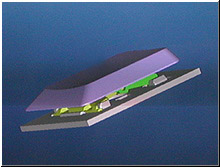Scissor-Switch Membrane Keyboards (i.e.
Keyboards with Scissor-Switch Membrane Keyswitches)
What is a Scissor-Switch Membrane Keyboard?
 Scissor-switch membrane
keyboards are a distinct subset of rubber dome switch
keyboards, which merit their own category due to their
widespread use in laptop and other portable keyboards.
This keyboard still utilizes rubber domes, but a special
plastic 'scissors' mechanism links the keycap to a plunger
that depresses the rubber dome with a much shorter travel
than the typical rubber dome keyboard. Typically scissors
switch keyboards employ the same standard 3-layer
membranes as the electrical component of the dome membrane
switch. The smaller, shallower footprint makes
scissor-switches popular on laptops and other portable
keyboards.
Scissor-switch membrane
keyboards are a distinct subset of rubber dome switch
keyboards, which merit their own category due to their
widespread use in laptop and other portable keyboards.
This keyboard still utilizes rubber domes, but a special
plastic 'scissors' mechanism links the keycap to a plunger
that depresses the rubber dome with a much shorter travel
than the typical rubber dome keyboard. Typically scissors
switch keyboards employ the same standard 3-layer
membranes as the electrical component of the dome membrane
switch. The smaller, shallower footprint makes
scissor-switches popular on laptops and other portable
keyboards.
What are the Characteristics of a
Scissor-Switch Membrane Keyboard?
Key Travel Distance: Scissor-switch
membrane keyswitches are not 'full-travel' and typically
have a key travel distance of 1 - 2.5 mm as compared to
2.5 - 4 mm for membrane keyboards. As such, when
typing on these keyboards it is almost impossible to
prevent 'bottoming out' on every keystroke.
Noise Level: Scissor-switch
membrane keyswitches are noisier than regular membrane as
the physical characteristics of the switch reduce the
amount of rubber or silicon in the switch, reducing the
'cushioning' that is available. In addition the
scissor mechanisms help to optimize the elasticity of the
rubber, resulting in a distinct noise when keys return to
the original 'up' position that is not a factor on dome
membrane keyboards without scissor-switches.
Durability: Most standard
scissor-switch keyswitches are rated at 5 million
keystrokes, however some manufacturers use superior
materials and have ratings of as high as 10 million
keystrokes. They are harder to clean than dome
membrane keyboards (due to the limited movement of the
keys) but also less likely to get debris in them as the
gaps between the key cap tops are often less. This
is because there is no need for extra room to allow for
the 'wiggle' in the key as you would find on a membrane
keyboard.
Key Activation Force: The
'factory' actuation force varies widely, and can be as low
as 65 grams or as high as 100 grams. Most
scissor-switch membrane keyswitches are rated between 65
and 85 grams.
Tactility
('Feel'): Most scissor-switch membrane
keyswitches have a crisper more tactile feel than regular
dome membrane keyboards. They also feel more solid
as they are stabilized by the scissor-switches which
prevent side to side or twisting movement during key
travel.

 Scissor-switch membrane
keyboards are a distinct subset of rubber dome switch
keyboards, which merit their own category due to their
widespread use in laptop and other portable keyboards.
This keyboard still utilizes rubber domes, but a special
plastic 'scissors' mechanism links the keycap to a plunger
that depresses the rubber dome with a much shorter travel
than the typical rubber dome keyboard. Typically scissors
switch keyboards employ the same standard 3-layer
membranes as the electrical component of the dome membrane
switch. The smaller, shallower footprint makes
scissor-switches popular on laptops and other portable
keyboards.
Scissor-switch membrane
keyboards are a distinct subset of rubber dome switch
keyboards, which merit their own category due to their
widespread use in laptop and other portable keyboards.
This keyboard still utilizes rubber domes, but a special
plastic 'scissors' mechanism links the keycap to a plunger
that depresses the rubber dome with a much shorter travel
than the typical rubber dome keyboard. Typically scissors
switch keyboards employ the same standard 3-layer
membranes as the electrical component of the dome membrane
switch. The smaller, shallower footprint makes
scissor-switches popular on laptops and other portable
keyboards.